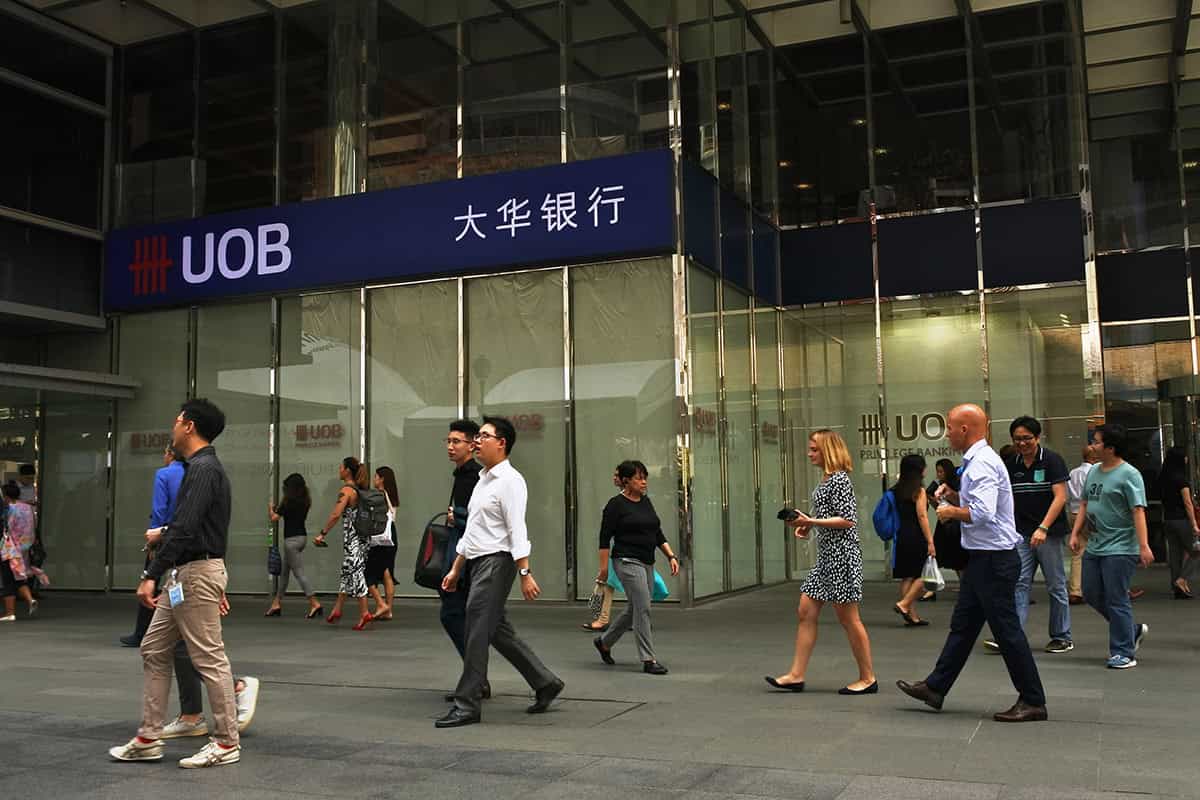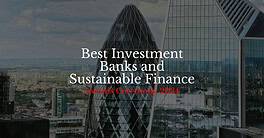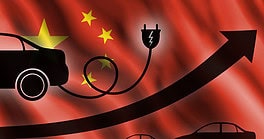However, the second-largest economy remains conspicuously absent.
In the Asia-Pacific (APAC) region last year—as in 2022—net interest margin (NIM) dynamics were optimal for banks in Southeast Asia, Australasia, Hong Kong and India. Lending rates followed central bank tightening moves, while deposit rates lagged; and across the region, there were some record profits.
In Japan, profits at the country’s five most prominent banking groups leapt 56% to a record ¥2 trillion (about $12.6 billion) in the fiscal second half as lending spreads widened.
By contrast, China’s banking system suffered from weak loan demand as the property crisis weighed on sentiment, and NIMs contracted for a second consecutive year.
Meanwhile, according to an International Data Corp. survey, most banks across APAC increased 2023 tech budgets to boost security, transform data and avoid downtime. Over 70% of banks in APAC expected environmental, social and governance (ESG) initiatives to boost profitability—albeit a challenging measure to acquire.
| Best Banks in Asia-Pacific | |
|---|---|
| Afghanistan | AIB |
| Australia | CBA |
| Azerbaijan | Pasha Bank |
| Bangladesh | Standard Chartered Bangladesh |
| Brunei Darussalam | Baiduri Bank |
| Cambodia | ABA Bank |
| China | China Construction Bank |
| Hong Kong | HSBC |
| India | State Bank of India |
| Indonesia | Bank Mandiri |
| Japan | MUFG Bank |
| Kazakhstan | ForteBank |
| Kyrgyzstan | Halyk Bank Kyrgyzstan |
| Macau | ICBC |
| Malaysia | Maybank |
| Mongolia | Khan Bank |
| Myanmar | uab bank |
| Nepal | Global IME Bank |
| New Zealand | ANZ New Zealand |
| Pakistan | Habib Bank |
| Philippines | Metrobank |
| Singapore | UOB |
| South Korea | Hana Bank |
| Sri Lanka | Commercial Bank of Ceylon |
| Taiwan | E.Sun |
| Thailand | Bangkok Bank |
| Uzbekistan | Tenge Bank |
| Vietnam | Techcombank |
Regional Winner

United Overseas Bank (UOB) has focused its growth strategy on ASEAN. Its expansion into the region via the $5 billion Singapore dollars (about $3.7 billion) acquisition of Citigroup’s regional consumer banking business in 2022 bore fruit in 2023, more than doubling its customer base outside Singapore.
The move aligns UOB, which also won the Best Bank in Singapore, with ASEAN’s rise as an economic powerhouse, rapidly transformed via megatrends like supply chain diversification, digitalization and investments in net-zero transitions and a rising middle class.
Last year, UOB fully integrated its acquired Indonesian and Malaysian businesses onto the bank’s platforms while the migration of the Thai and Vietnamese businesses will be completed in the first half of 2024 and 2025, respectively. In 2023, the bank’s financial data metrics were impeccable: a 27% increase in net profit to a record S$6.1 billion; a 2.3% rise in return on equity (ROE) to 14.2%; and gains in tier 1 equity capital and assets of 5% and 4%, respectively.
The Citigroup acquisition bore immediate fruit in the e-payments line, with 25% growth in customers in ASEAN, 26% growth in transaction value to S$129 billion and the capture of 40% market share in Malaysia via the DuitNow e-payment corridor and 60% in Thailand via PromptPay.
China and Environs
China’s banks faced a challenging 2023 due to feeble retail and mortgage loan demand, policy initiatives directing cut-rate lending to strategic sectors, and dwindling NIMs, which fell 22 basis points (bps) over the year, extending 2022’s decline.
Against this inauspicious backdrop, China Construction Bank (CCB) impressed judges with an array of initiatives demonstrating innovative technological thinking and a keen eye on ESG alignment, regional development and inclusivity.
Given the turbulent domestic property market, a particularly savvy initiative involved closed-loop services aimed at improving China’s rental-housing environment. CCB invested 4.9 billion renminbi (about $676 million) under its Housing Rental Fund; and via the CCB Home long-term rental program, the bank’s corporate lending to the rental sector exceeded 300 billion renminbi.
Digital capability led to an upgrade of the CCB Huidongni app, which provides inclusive loans, boosting this portfolio of offerings by 22% to 2.9 trillion renminbi. Rural revitalization was facilitated via the Yunongtong app, which provides basic financial services to farmers.
Meanwhile, HSBC had a banner year in Hong Kong, raking in $24.6 billion after-tax profit versus $8.3 billion in 2022. This was primarily based on revenue growth, which registered a heady 30% rise, allowing the bank to distribute its highest full-year dividend since 2008.
In the culmination of a four-year cost-to-achieve program, the bank eliminated recurrent resturcturing cost and reduced operating expenses by 2%.
Rising external interest rates, a weak economic recovery and risk management challenges put neighboring Macau’s banking environment under pressure. Nonperforming loans (NPLs) surged from 0.26% before the pandemic to 3%—a complex backdrop that demanded transformative action from ICBC (Macau).
In response, the bank focused on long-term sustainable development, transformed its operations, compressed its asset scale, optimized its liability structure and boosted noncredit profit lines.
Provisioning costs hit profits, but ICBC’s strategy of “basing on Macau, integrating into the Greater Bay Area, expanding in Portuguese-speaking countries and extending to the countries along the Belt and Road route” remained intact.
Taiwan’s E.Sun bank stunned last year with profits of $21.7 billion Taiwan new dollars (about $665 million), for a 38.1% gain, all the more impressive for being achieved by an 11.6% rise in fee income (to NT$21.5 billion), which broke the bank’s all-time quarterly record in the final quarter of 2023, when it booked a hefty NT$5.8 billion in fees.
The bank’s offshore business expansion also saw a massive return, as overseas profit surged 102.9% and contributed 35.8% of E.Sun’s overall profit.
Northern Asia
Japan’s banks benefited from rising NIMs in dollar loans last year. At the same time, margins improved on longer-term yen loans thanks to the Bank of Japan (BOJ) easing caps on the 10-year Japanese government bond in its yield curve control program. The NIM at Japan’s three largest banks hit 56 bps, the highest since the BOJ started its negative interest rate regime in 2012.
Banking colossus MUFG Bank reaped ¥80 billion to its profit and loss statement from a bumper year at its domestic affiliates, including Morgan Stanley securities operations, where combined profits hit ¥381 billion in fiscal 2023. The company also benefited from a 33 bps increase on overseas lending spreads, principally in US dollar funding. Net operating profits across the group in the year to September rose 16% to ¥1.8 trillion.
MUFG demonstrated a solid commitment to shareholders last year. The group’s market capitalization in 2023 was at a 17-year high, valuing the enterprise at around the same level in dollar terms as Goldman Sachs.
Meanwhile, South Korea’s Hana Bank delivered a 34% gain in net income in fiscal 2023, with a notable 15.4% increase in fee income. In addition, it benefited from improved net lending margins thanks to the Bank of Korea’s base rate-tightening campaign.
Hana has led the way in Korean banking’s funding alternatives to the deposit base, with frequent issuance in the international debt capital markets. Last year, it innovated by visiting the euro market via a €600 million (about $642 million) covered social bond, building on US dollar issuance over the previous two years in a sustainability-linked format. This underscored Hana’s commitment to ESG alignment, the bank having joined the Equator Principles in 2021 and the Net-Zero Banking Alliance in 2022.
Australasia
The post-Covid recovery went gangbusters in the Australian banking sector last year. KPMG Australia reported that the “Big Four” banks generated 32.5 billion Australian dollars (about $21.2 billion) in profit, for a 12.4% year-on-year (YoY) gain.
The country’s largest lender, Commonwealth Bank of Australia (CBA), led the pack with the biggest profit—a record AU$10.2 billion—besting the other three significant lenders (NAB, ANZ and Westpac) by around AU$ 3 billion each. NIM rose in the first half by 23 bps to 2.1%, and earnings growth‚ unsurprisingly, was driven by a 19% increase in net interest income. Volume growth was recorded across CBA’s product suite including home loans—which it dominates, providing 25% of retail mortgages in the country—and business loans.
CBA struck a cautious tone in its 2023 annual report, noting a rise in loan delinquencies. Still, shareholders had reason to smile: In August, it announced an AU$1 billion share buyback and paid a final dividend of AU$2.40 per share for a record annual AU$4.50 payout.
Meanwhile, ANZ New Zealand had a bumper year, but also stuck a cautious tone.
Despite going from the Covid fiscal stimulus tailwind to a series of rapid interest rate increases from 2022 to 2023, the bank achieved 2.3 billion New Zealand dollars (about $1.4 billion) in cash profit for fiscal 2023—a 10% YoY gain. Revenue rose 10% and home lending by 3%; but provisioning against sour loans increased, and profits fell 22% in the final quarter as NPLs rose above NZ$1 billion.

The Subcontinent
Demand for consumer loans propelled Indian banks’ loan portfolio growth into double digits last year. The State Bank of India (SBI), the country’s largest asset lender, reduced its recent focus on the retail segment for baseline expansion and turned its attention to corporates.
Overall loan growth was 15% last year; but the days of 30% to 33% annual unsecured retail loan growth ended, being crimped to 18% while corporate lending filled the gap.
The bank has an auspicious ratio of current account savings accounts (CASA) and focused last year on the cross-selling product opportunity afforded by its 22,400-branch network. SBI continued to reduce NPLs, reducing its gross nonperforming assets ratio by 72 bps, to 2.42%
Pakistan’s Habib Bank, the country’s oldest commercial bank, scored its highest-ever profit in 2023, pulling in 57.8 billion Pakistani rupees (approximately $208 million), a 68% surge.
Assets and deposits both hit record growth—each up by 19%—and all of the bank’s product offerings, including consumer loans, agriculture lending and microfinance, hit new benchmark highs. The lending margin backdrop was turbocharged by rising central bank policy rates, surging 159 bps. In contrast, fee income rose 34%, mainly on the back of HBL’s cards business, which dominates retail consumer credit in the country.
According to its website, the vision of the Commercial Bank of Ceylon (CBC) is “to be the most technologically advanced, innovative and customer-friendly financial services organization in Sri Lanka.” This might have proved challenging during the past few years of economic turmoil, but CBC is on its way.
In 2023, its tech-driven new product offerings impressed, particularly the Commercial Bank LEAP GlobalLinker, a pioneering scheme to create a digital business ecosystem in the country, aimed at small and midsize enterprises (SMEs). At the same time, CBC grabbed the most market share for deposits and loans in Sri Lanka and grew its ESG footprint with schemes such as collaboration with the Green Building Council, which will promote sustainable construction in the country.
Nepal’s Global IME Bank (GIB) serves 4.6 million domestic customers and focuses 55% of lending on the retail and SME segments. GIB has interests in hydropower, manufacturing, textiles, services, aviation, exports, trading and microfinance. It was the first handling bank unit of the Central Renewable Energy Fund. Its ESG credentials were further burnished by establishing a disaster recovery system in natural disaster prone western region of Nepal, about 125 miles west of Kathmandu.
Standard Chartered Bangladesh (SCB) has been serving the country for 119 years. It has facilitated investments in power, energy, transportation and urban development, with a keen eye on lending to the SME sector, It is the country’s only universal international bank.
An eye-opening innovation unveiled last year was the first-ever end-to-end digital cross-border letter of credit, which was utilized by Heidelberg Cement Bangladesh and was made possible by an amendment to Bangladesh’s Import Policy Order. Moreover, SCB arranged the first private sector “recourse” financing to help reduce greenhouse gas emissions in the country’s steel industry via solar power generation, air pollutant management systems and water treatment.
Southeast Asia
Malaysia’s Maybank is galvanized around its M25+ action plan, which aims at revenue diversification and operational efficiency while keeping a sharp eye on meeting sustainable goals. The bank operates around its pioneering Group Transition Finance Framework. In 2023 it received the highest rating in the Carbon Disclosure Project among local peers, scoring a B versus the Asia regional C rating.
Maybank’s 60 sen (about $0.13) dividend was the highest payout since the pandemic. Meanwhile, its ROE rose from 9.6% to 10.8%, and net profit grew 17.5% to 9.35 billion ringgit (about $2 billion).
In neighboring Brunei Darussalam, Baiduri Bank reported a blowout of 15.8% ROE, a 24% surge from the previous year. The operational efficiency required to achieve this stunning metric was made plain in the bank’s supertight 38.2 cost-to-income ratio, which squeezed in by 23%. Total assets grew 11.5%, and net profit surged 37%.
The bank trod new paths, including its presence in overseas syndicated loan groups and via innovative strategies from its treasury team in asset and liability management, focused on overseas financial markets, especially its neighbor Singapore.
Bangkok Bank (BBL) booked a handy 42% rise in profits in 2023 for 8% ROE, an impressive result given the bank’s relatively cautious lending stance: Its loan-to-deposit ratio was 84%, versus around 107% for the Thai banking system.
Thailand’s largest commercial bank, BBL has led, managed and participated in public debt issuance across the entire spectrum, from plain vanilla to structured and ESG-compliant debt.
The bank also rolled out game-changing products during 2023, including PromptBiz, an e-payments corridor that is part of the Bank of Thailand’s national digital service, and a digital-lending pilot project for microenterprises that utilizes digital data and end-to-end digital approval.
Higher NIMs and improved asset quality—which boosted non-interest income—allowed the Philippines’ Metropolitan Bank and Trust Co (Metrobank) to book a 29% gain in attributable net profit last year, with earnings surging 39% in the third quarter.
Metrobank kept costs low last year, reducing its cost-to-income ratio by more than 3% to 51.5%. Its trading and foreign exchange departments scored a 45.5% gain, booking 3.6 billion pesos (about $62.4 million) in trading profits.
Indonesia’s Bank Mandiri focused on corporate credit growth last year, increasing its loan portfolio in the segment by 18.3% to 490 billion Indonesian rupiah (about $30.2 million). The micro, small and midsize enterprise segments grew by 14% and 10.4%, respectively, and overall asset quality at the bank improved. NPLs fell by a chunky 86 bps to just 1.02% and are covered by 384%.
The bank also recorded the highest profit in its 25-year history, 55 trillion rupiah ($3.5 billion), for a 33.7% gain over 2022.
Vietnam’s Techcombank acquired 2.6 million new customers last year— double 2022’s customer growth. In the process, it boosted deposits by 26.9% and total credit assets, including loans and credit card assets, by 19.2%. The healthy deposit dynamic at the start of the year continued into the final quarter, with CASA rising to 40%. Vietnam’s cutthroat banking market softened Techcom’s asset yields with competitive loan pricing. However, after contracting in the first three quarters, its NIM expanded by 11.4% in the third quarter, which allowed pretax profits to rise 22% in 2023.
Advanced Bank of Asia (ABA), Cambodia’s largest commercial lender, wholly owned by the National Bank of Canada, increased profit by 5.4% in 2023, pulling in $276.5 million. Wholesale and retail trade loans dominated ABA’s loan portfolio, with the rest lent to the services sector, real estate, construction and manufacturing. Total asset value grew 27% over the year, and the bank continued to restructure loans that had become nonperforming during the pandemic.
Myanmar’s UAB Bank scored an eye-popping 17% ROE in 2023 and managed to subdue NPLs to 6%. UAB has become a model within the “S” of ESG, demonstrating corporate empathy within a country still reeling from the effects of the 2021 military coup. It has organized campaigns to donate rice, funded orphanages and monasteries, provided scholarships for the underprivileged, sponsored sporting and artistic talent and organized excursions for the elderly, all under the slogan “No one is left out.”
Central Asia and the Caucasus
Afghanistan International Bank (AIB), one of the country’s largest commercial banks, enjoys its unique status as the country’s only US dollar clearer—with the ability to transfer internationally without country restriction—and as a conduit to multilateral lenders and nongovernment organizations. After-tax profit in 2023 was 1.3 billion Afghan afghanis (about $18 million), a 29% YoY gain.

Mongolia’s Khan Bank outpaced the competition in 2023. Its 424 billion tugrik (about $125 million) profit exceeded the combined earnings of the country’s four other large banks. This was an impressive result given the expiration of the no-interest clause on demand deposits and current accounts that had been introduced due to the Covid-19 pandemic.
Roughly 1.7 million of Mongolia’s population of 3.5 million people use the digital platform from Kahn Bank, and AI automation has helped streamline 10 processes across the application. This includes a digital signature feature that massively reduces paper usage and helps the bank become more eco-friendly.
Kazakhstan’s ForteBank—the country’s fifth-largest lender in terms of assets—enjoyed a one-notch long-term-issuer upgrade from Fitch Ratings in August to BB. Fitch cited the bank’s “intrinsic credit strength” and the reduction of its NPLs from 13% at the end of 2021 to 9% at the end of the first half of 2023.
Pasha Bank, Azerbaijan’s largest private bank by total equity, booked an extraordinary 510% profit gain last year via its diversified operational model, which includes investment banking, trade finance and asset management for businesses ranging from SMEs to the largest corporations. In 2023, the bank leveraged its 8.9 billion manat (about $5.2 billion) in consolidated assets to post industry-beating profits.
Tenge Bank, a subsidiary of preeminent Central Asian lender Halyk Bank, has made rapid progress since its start in 2019. It covers 90% of Uzbekistan country’s population via 17 branches and through its mobile app, Tenge24, which added online account opening and virtual card issuance in 2023.
Meanwhile, Halyk Bank Kyrgyzstan, a universal bank, provides financial services to large corporations, SMEs and retail customers. Since opening its doors, it has built up correspondent relationships with large banks in Germany, Russia, South Korea and Kazakhstan and serves the population via 19 branches. Kazakh parent Halyk Bank sold the bank last year to a consortium of buyers led by Visor International, an investment group with interests in Central Asia.




